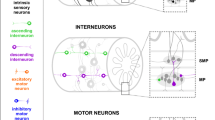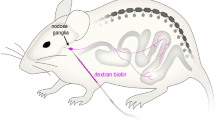Abstract
We have analyzed, by the sucrose gap method, the action of otilonium bromide, a quaternary ammonium derivative in use for the symptomatic therapy of irritable bowel syndrome, on the electrical and mechanical responses initiated by different stimuli in the circular muscle of the guinea-pig proximal colon. Otilonium bromide produced a concentration-dependent inhibition of membrane depolarization (IC50 4.1 µM), action potentials (APs) and contraction (IC50 3.7 µM) produced by the muscarinic receptor agonist, methacholine. It also produced a concentration-dependent inhibition of APs and accompanying contraction (IC50 31 µM) produced by KCl (30 mM), and had a biphasic effect on the cholinergic excitatory junction potential (e.j.p.) produced by single pulse electrical field stimulation: at low concentrations (0.1–0.3 µM) otilonium bromide enhanced the e.j.p. and, at higher concentrations (IC50 22 µM and 16 µM toward depolarization and contraction), produced a concentration-dependent inhibition. Otilonium bromide eliminated the APs superimposed on the depolarization induced by the tachykinin NK1 receptor agonist, [Sar9]substance P-sulphone and suppressed the corresponding contraction (IC50 43 µM) but had little effect on the sustained membrane depolarization induced by this agonist. On the other hand, otilonium bromide produced a similar inhibitory effect on both membrane depolarization and contraction (IC50 38 µM and 45 µM, respectively) induced by the tachykinin NK2 receptor agonist [βAla8]neurokinin A (4–10). When tested in the presence of nifedipine (1 µM), otilonium bromide had no effect on the membrane depolarization induced by [Sar9]substance P-sulphone but inhibited in a concentration-dependent manner the depolarization induced by [βAla8]neurokinin A (4–10) (IC50 41 µM). In contrast, the blocker of receptor-operated cation channels, SKF 96365, inhibited with similar potency the depolarization induced by both [Sar9]substance P-sulphone and [βAla8]neurokinin A (4–10) (IC50 60 µM and 54 µM, respectively). In radioligand binding experiments otilonium bromide produced a concentration-dependent inhibition of the binding of both an agonist ([125I]neurokinin A, K i 7.2 µM) and an antagonist ([3H]SR 48968, K i 2.2 µM) to membranes of Chinese hamster ovary cells transfected with the human tachykinin NK2 receptor. In conclusion, the present findings demonstrate that, in the µM range of concentrations, otilonium bromide acts as a muscarinic and tachykinin NK2 receptor antagonist and as a calcium channel blocker. The latter property is likely to account for its ability to suppress contraction initiated by the tachykinin NK1 receptor agonist. Therefore multiple mechanisms of action account for the ability of otilonium bromide to reduce stimulated motility of intestinal smooth muscle.
Similar content being viewed by others
Author information
Authors and Affiliations
Additional information
Received: 27 November 1998 / Accepted: 2 February 1999
Rights and permissions
About this article
Cite this article
Santicioli, P., Zagorodnyuk, V., Renzetti, A. et al. Antimuscarinic, calcium channel blocker and tachykinin NK2 receptor antagonist actions of otilonium bromide in the circular muscle of guinea-pig colon. Naunyn-Schmiedeberg's Arch Pharmacol 359, 420–427 (1999). https://doi.org/10.1007/PL00005370
Issue Date:
DOI: https://doi.org/10.1007/PL00005370




